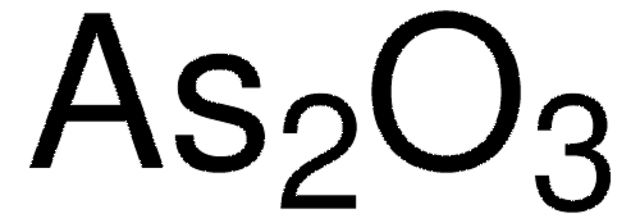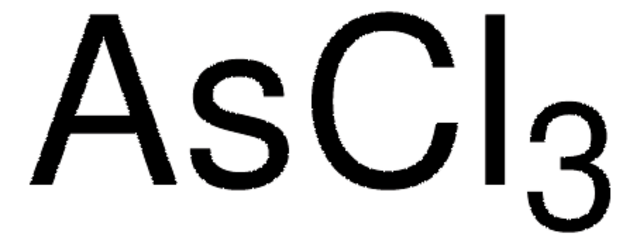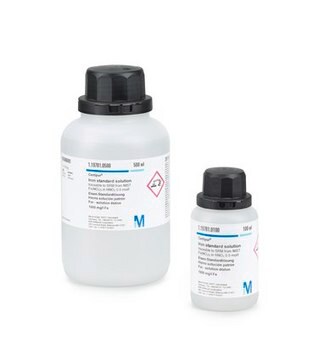311383
Arsenic(III) oxide
ACS reagent (primary standard)
Synonyme(s) :
Arsenic trioxide, Arsenous acid
About This Item
Produits recommandés
Qualité
ACS reagent (primary standard)
Niveau de qualité
Pression de vapeur
0 hPa ( 66 °C)
Essai
99.95-100.05%
Forme
powder
Pertinence de la réaction
reagent type: catalyst
core: arsenic
Résidus de calcination
≤0.02%
Solubilité
dilute HCl: insoluble ≤0.01%
Traces d'anions
S2-: passes test (lim. ~0.001%)
chloride (Cl-): ≤0.005%
Traces de cations
Fe: ≤5 ppm
Pb: ≤0.002%
Sb: ≤0.05%
Chaîne SMILES
O=[As]O[As]=O
InChI
1S/As2O3/c3-1-5-2-4
Clé InChI
IKWTVSLWAPBBKU-UHFFFAOYSA-N
Vous recherchez des produits similaires ? Visite Guide de comparaison des produits
Catégories apparentées
Description générale
Application
- In the synthesis of arsenic pentafluoride (AsF5) by static fluorination method in a closed system.
- In the preparation of arsenic-doped ZnO films by adding As2O3 to zinc acetate, 2-methoxyethanol, and monoethanolamine by sol-gel spin coating method.
Mention d'avertissement
Danger
Mentions de danger
Classification des risques
Acute Tox. 2 Oral - Aquatic Acute 1 - Aquatic Chronic 1 - Carc. 1A - Eye Dam. 1 - Skin Corr. 1B - STOT RE 1
Organes cibles
Respiratory system,Cardio-vascular system,Gastrointestinal tract
Code de la classe de stockage
6.1A - Combustible acute toxic Cat. 1 and 2 / very toxic hazardous materials
Classe de danger pour l'eau (WGK)
WGK 3
Point d'éclair (°F)
Not applicable
Point d'éclair (°C)
Not applicable
Faites votre choix parmi les versions les plus récentes :
Déjà en possession de ce produit ?
Retrouvez la documentation relative aux produits que vous avez récemment achetés dans la Bibliothèque de documents.
Les clients ont également consulté
Notre équipe de scientifiques dispose d'une expérience dans tous les secteurs de la recherche, notamment en sciences de la vie, science des matériaux, synthèse chimique, chromatographie, analyse et dans de nombreux autres domaines..
Contacter notre Service technique











